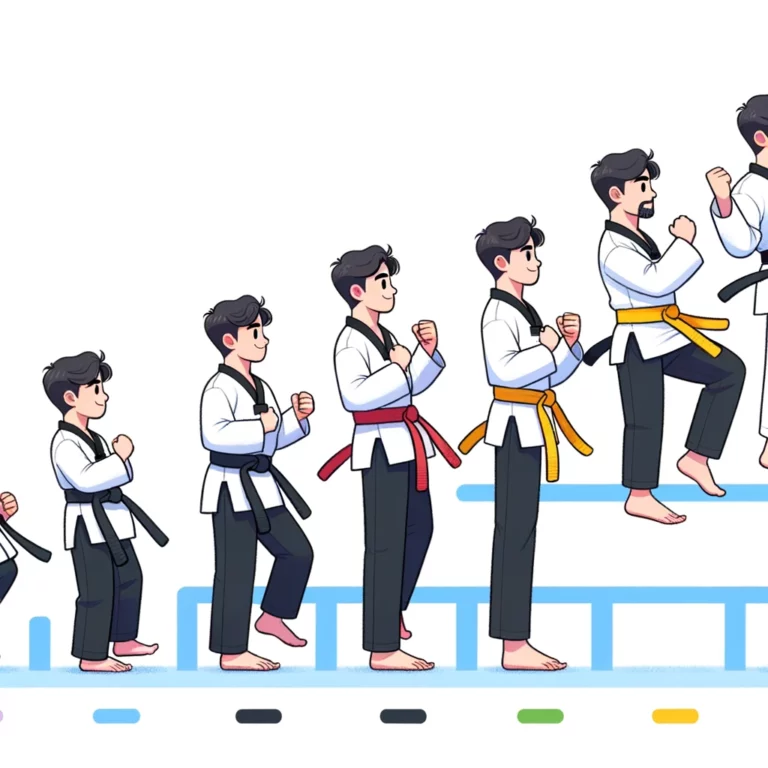The Hierarchy of Taekwondo Belt Colors: Understanding the Progression
In Taekwondo, the hierarchy of belt colours serves as a visual representation of a practitioner’s progress and skill level. Beginning with a white belt, students embark on a journey of knowledge, discipline, and self-improvement. They gradually move up the ranks as they train and hone their techniques, earning new belt colours that signify their growth and mastery. Each belt colour holds significance and meaning, symbolising the accomplishments and milestones the dedicated taekwondo practitioners achieved.
The progression of belt colours in Taekwondo follows a systematic order, with each colour building upon the skills acquired in the previous level. After obtaining the white belt, students advance to the yellow, green, blue, red, and black belts. Each colour represents a stepping stone in one’s journey of self-improvement, with specific requirements and challenges that must be overcome to reach the next level. This systematic progression allows students to build a strong foundation and develop a comprehensive understanding of Taekwondo’s various techniques and principles. It also serves as a reminder of the dedication and commitment required to excel in this martial art.

The Significance of Different Taekwondo Belt Colors and Their Meanings
When it comes to understanding different Taekwondo belt colours and colour meanings, it is essential to recognise that each colour represents a specific stage of progression and achievement within the martial The colour white, for example, symbolises purity and the beginning stages of training in Taekwondo. As students gain more knowledge and experience, they move on to yellow, which signifies the Earth and the growth of their skills.
Moving up the hierarchy, the orange belt represents the colour of the setting sun, representing a sense of energy and warmth. On the other hand, the green plant’s growth highlights the continued progress and development of a practitioner’s techniques. Blue belt, reminiscent of the sky, represents expansion and widening horizons in Taekwondo. Finally, brown signifies the Earth’s fertile soil, symbolising the advanced knowledge and skills that a practitioner has acquired. Understanding the significance behind these belt colours and their meanings helps students recognise the milestones they have achieved and motivates them to continue their journey towards mastery in Taekwondo.
The Evolution of Taekwondo Belt Systems: From White to Black
The evolution of taekwondo belt systems has been a fascinating journey, reflecting the growth and development of this martial art over time. It all begins with the white belt, symbolising purity and an empty vessel ready to be filled with knowledge and skill. As beginners enter the world of Taekwondo, they start with a clean slate, eager to learn and improve themselves. With each belt colour transition, practitioners advance their proficiency and understanding, gaining new techniques and strategies to enhance their physical and mental abilities.
From the white belt, yellow is the next colour in the progression. Representing the sun and warmth, the yellow belt signifies the dawning of a new day in a taekwondo practitioner’s journey. It marks the awakening of their skill as they start to grasp the fundamental techniques and develop a solid foundation. The yellow belt stage is crucial in building confidence and setting the stage for growth in the higher belt levels. It bridges the novice stage and the more specialised aspects of taekwondo training, preparing students to take on new challenges and expand their repertoire of moves.

The Importance of Belt Testing in Taekwondo: Advancing Through the Ranks
Belt testing is a fundamental aspect of Taekwondo that allows practitioners to advance through the ranks. It assesses one’s skills, knowledge, and overall progress in the martial art. Through rigorous examinations, students can demonstrate their proficiency in various techniques, forms, sparring, and self-defence. Completing these tests is essential for individuals to move on to the next belt colour and continue their journey towards mastery.
The importance of belt testing lies in the tangible recognition of one’s accomplishments and the personal growth and development it fosters. Each level of testing presents new challenges and opportunities for practitioners to expand their skill sets and push their limits. In preparing for these examinations, students learn discipline, perseverance, and the value of hard work. Additionally, belt testing promotes a sense of camaraderie among students as they support and encourage each other’s progress. Through this process, practitioners genuinely understand the significance of their Taekwondo journey and the dedication required to advance through the ranks.
Exploring the Different Levels of Taekwondo Belts: From Beginner to Expert
In Taekwondo, the journey from being a beginner to becoming an expert is marked by the progression through different levels of belts. Each level represents an individual’s growth, skill development, and commitment to mastering the art form. The first stage begins with the white belt, signifying purity and innocence. As the practitioner gains confidence and proficiency, they move on to the yellow belt, representing the Earth and the foundation for building skills.
From there, the journey continues with the green belt, symbolising the growth and potential for further advancement. The blue belt follows, representing the sky and broadening knowledge and practice techniques. Progressing further, the practitioner reaches the red belt, signifying danger and caution, as they approach the pinnacle of their journey. Finally, the journey culminates in the coveted black belt, representing the completion of the basic training and the readiness to enter the realm of expert practitioners in Taekwondo.
As one explores the different levels of taekwondo belts, it becomes evident that each stage requires dedication, discipline, and perseverance. Each belt level brings new challenges, techniques, and responsibilities, constantly pushing the practitioner to strive for self-improvement. The journey from a beginner to an expert in Taekwondo depends not solely on acquiring physical skills but also on developing mental fortitude and moral values. Through this continuous growth and determination, a practitioner can truly embody the essence of Taekwondo and realise their full potential in this ancient art form.
• White Belt: Represents purity and innocence
• Yellow Belt: Symbolises the Earth and serves as a foundation for skill development
• Green Belt: Signifies growth and potential for further advancement
• Blue Belt: Represents the sky and broadening knowledge and practice techniques
• Red Belt: Indicates danger and caution as the practitioner approaches the pinnacle of their journey
• Black Belt: The coveted belt that represents the completion of basic training and readiness to enter expert-level
– Each belt level requires dedication, discipline, and perseverance.
– New challenges, techniques, and responsibilities come with each belt level.
– The journey from beginner to expert involves the physical development of CAL skills development.
– Moral values are also emphasised in taekwondo training.
– Continuous growth is necessary to fully embody the essence of Taekwondo.

What is the hierarchy of Taekwondo belt colours?
The hierarchy of Taekwondo belt colours starts with white for beginners and progresses through yellow, green, blue, red, and black for experts.
What do the different Taekwondo belt colours signify?
Each Taekwondo belt colour represents a certain level of skill and knowledge in the martial art. For example, white symbolises purity and innocence, while black signifies mastery and expertise.
How has the Taekwondo belt system evolved?
The Taekwondo belt system has evolved from a simple white belt to a black belt progression, including various intermediate belt colours such as yellow, green, blue, and red. This allows for a more gradual progression and recognition of skill development.
Why is belt testing necessary in Taekwondo?
Belt testing is essential in Taekwondo as it serves as a way to evaluate a practitioner’s progress and determine if they are ready to advance to the next level. It helps ensure that students acquire the necessary skills, knowledge, and discipline required for each belt rank.
What are the different levels of Taekwondo belts?
The different levels of Taekwondo belts range from beginner to expert. This includes white, yellow, green, blue, red, and black belts. Each belt represents a different stage of proficiency and understanding in the art of Taekwondo.







